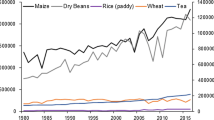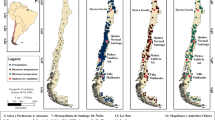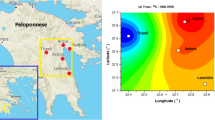Abstract
This study analyses the decadal changes in winter precipitation and extreme precipitation in a warming environment in China. The results show that, together with a trend of winter warming in China, winter precipitation and extreme precipitation in the region are also increasing. In addition, concurrent with the decadal warming shift that occurred in the mid-1980s, precipitation and extreme precipitation both increased significantly. Quantitative analysis shows that precipitation and extreme precipitation increased at rates of 9.7% and 22.6% per 1°C of surface warming in China. This rate of precipitation increase is greater than the global mean, which indicates that precipitation in China is highly sensitive to climate warming and further highlights the importance of studying regional responses to climate warming. The fact that extreme precipitation is increasing at a higher rate than precipitation implies that winter precipitation in China will increasingly be of more extreme type in the context of global warming, which could partly explain why there have recently been a number of record-breaking extreme snowfall events in China.
Article PDF
Similar content being viewed by others
Avoid common mistakes on your manuscript.
References
Trenberth K E Fasullo J, Smith L. Trends and variability in column-integrated atmospheric water vapor. Clim Dyn, 2005, 24: 741–758
Wentz F J Ricciardulli L, Hilburn K, et al. How much more rain will global warming bring? Science, 2007, 317: 233–235
Held I M Soden B J. Robust responses of the hydrological cycle to global warming. J Clim, 2006, 19: 5686–5699
Lambert F H Stine A R Krakauer N Y. How much will precipitation increase with global warming? EOS, 2008, 89: 193–200
Previdi M, Liepert B G. Interdecadal variability of rainfall on a warming planet. EOS, 2008, 89: 193–195
Trenberth K E Jones P D Ambenje P, et al. Observations: Surface and atmospheric climate change. In: Solomon S, Qin D, Manning M, et al., eds. Climate Change 2007: The Physical Science Basis. Contribution of Working Group I to the Fourth Assessment Report of the Intergovernmental Panel on Climate Change. Cambridge and New York: Cambridge University Press, 2007. 254–265
Committee of China’s National Assessment Report on Climate Change. China’s National Assessment Report on Climate Change (in Chinese). Beijing: Science Press, 2007. 18–42
Zhai P M Pan X H. Trends in temperature extremes during 1951–1999 in China. Geophys Res Lett, 2003, 30: 1913–1916
Wang H J Sun J Q Chen H P, et al. Extreme climate in China: Factors, simulation and projection. Meteorol Z, 2012, doi: 10.1127/0941-2948/2012/0330
Qian W H Fu J L Yan Z W. Decrease of light rain events in summer associated with a warming environment in China during 1961–2005. Geophys Res Lett, 2007, 34: L11705
Zhao P, Yang S, Yu R C. Long-term changes in rainfall over eastern China and large-scale atmospheric circulation associated with recent global warming. J Clim, 2009, 23: 1544–1562
Li Z, Yan Z W. Homogenized daily mean/maximum/minimum temperature series for China from 1960–2008. Atmos Oceanic Sci Lett, 2009, 2: 237–243
Ren G Y Guo J, Xu M Z, et al. Climate changes of China’s mainland over the past half century (in Chinese). Acta Meteorol Sin, 2005, 63: 942–956
Ding Y H Wang Z Y Song Y F, et al. Causes of the unprecedented freezing disaster in January 2008 and its possible association with the global warming (in Chinese). Acta Meteorol Sin, 2008, 66: 808–825
Sun J Q Wang H J Yuan W. A preliminary investigation on causes of the catastrophic snowstorm in March, 2007 in the northeastern parts of China (in Chinese). Acta Meteorol Sin, 2009, 67: 469–477
Wang H J Yu E T Yang S. An exceptionally heavy snowfall in Northeast China: Large-scale circulation anomalies and hindcast of the NCAR WRF model. Meteorol Atmos Phys, 2011, 113: 11–25
Sun J Q Wang H J Yuan W. Spatial-temporal features of intense snowfall events in China and their possible change. J Geophys Res, 2010, 115: D16110
Gao X J Shi Y, Zhang D F, et al. Climate change in China in the 21st century as simulated by a high resolution regional climate model. Chin Sci Bull, 2012, 57: 1188–1195
Wang H J He S P. Weakening relationship between East Asian winter monsoon and ENSO after mid-1970s. Chin Sci Bull, 2012, 57: 3535–3540
He S P Wang H J. An integrated East Asian winter monsoon index and its interannual variability (in Chinese). Chin J Atmos Sci, 2012, 36: 523–538
Hori M E Ueda H. Impact of global warming on the East Asian winter monsoon as revealed by nine coupled atmosphere-ocean GCMs. Geophys Res Lett, 2006, 33: L03713
Zhou L T. Impact of East Asian winter monsoon on rainfall over southeastern China and its dynamical process. Int J Climatol, 2011, 31: 677–686
Wang L Feng J. Two major modes of the wintertime precipitation over China (in Chinese). Chin J Atmos Sci, 2011, 35: 1105–1116
Author information
Authors and Affiliations
Corresponding author
Additional information
This article is published with open access at Springerlink.com
Rights and permissions
This article is published under an open access license. Please check the 'Copyright Information' section either on this page or in the PDF for details of this license and what re-use is permitted. If your intended use exceeds what is permitted by the license or if you are unable to locate the licence and re-use information, please contact the Rights and Permissions team.
About this article
Cite this article
Sun, J., Ao, J. Changes in precipitation and extreme precipitation in a warming environment in China. Chin. Sci. Bull. 58, 1395–1401 (2013). https://doi.org/10.1007/s11434-012-5542-z
Received:
Accepted:
Published:
Issue Date:
DOI: https://doi.org/10.1007/s11434-012-5542-z




